 "ttyymmnn" (ttyymmnn)
"ttyymmnn" (ttyymmnn)
03/15/2019 at 12:35 • Filed to: wingspan, Planelopnik, TDIAH
 7
7
 13
13
 "ttyymmnn" (ttyymmnn)
"ttyymmnn" (ttyymmnn)
03/15/2019 at 12:35 • Filed to: wingspan, Planelopnik, TDIAH |  7 7
|  13 13 |
!!! UNKNOWN CONTENT TYPE !!!
Welcome to
This Date in Aviation History
, getting of you caught up on milestones, important historical events and people in aviation from March 13 through March 15.
!!! UNKNOWN CONTENT TYPE !!!
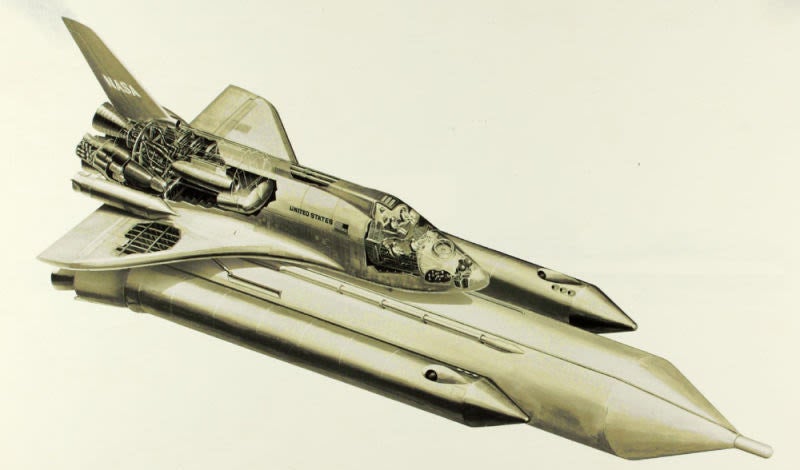
March 15, 1972 – NASA announces the final design of the Space Shuttle. Throughout the manned space program, from !!!error: Indecipherable SUB-paragraph formatting!!! to !!!error: Indecipherable SUB-paragraph formatting!!! to !!!error: Indecipherable SUB-paragraph formatting!!! , all parts of the launch system, from booster rockets to crew capsules, were expendable. But even before the first astronaut set foot on the Moon on July 21, 1969, NASA had already begun thinking about what future space travel would look like. As the space agency imagined the next generation of space vehicles, they considered ways to make at least part of the system reusable. In 1969, President Richard Nixon formed the !!!error: Indecipherable SUB-paragraph formatting!!! to investigate and develop a new launch system and vehicle that would be less expensive than previous systems, and one that could be used by NASA, the Department of Defense, and perhaps non-government commercial entities. But the biggest question that needed to be answered was just what form this new spacecraft, dubbed the Integrated Launch and Re-entry Vehicle (ILRV), would take.
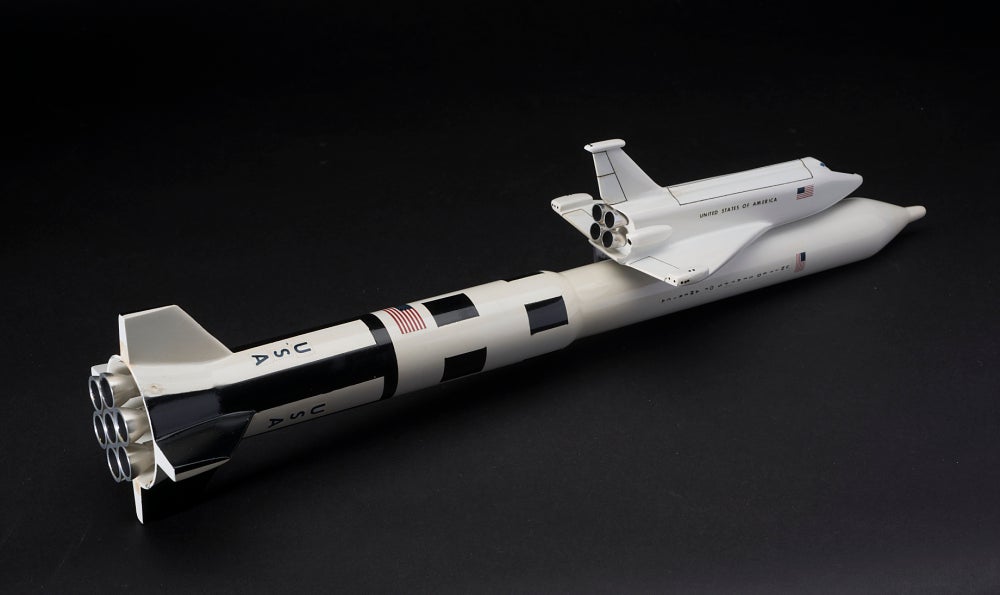 !!!CAPTION ERROR: MAY BE MULTI-LINE OR CONTAIN LINK!!!
!!!CAPTION ERROR: MAY BE MULTI-LINE OR CONTAIN LINK!!!
From the start, engineers envisioned a two-stage system that had the smaller vehicle, caller the orbiter, sitting atop a larger launch vehicle, called a booster. In its earliest guise, the booster wasn’t just a rocket, but had wings and pilots. The orbiter and booster would have launched vertically and, after the orbiter separated to continue its journey into space, the booster would be piloted back to Earth to be refueled and reused. Like the final Space Shuttle design, the booster would essentially be a flying fuel tank, but both the orbiter and booster were envisioned with air-breathing jet engines to allow controlled flight for landing. However, like so many other aspects of the post-Apollo space effort, economics played a major role, and NASA simply didn’t have the money to pursue such an ambitious system, along with the creation of the orbiting space station that the ILRV was meant to service. The original concept would only lift about 25,000 pounds of payload into orbit, and the US Air Force, whose money was vital to the program, wanted a payload of 65,000 pounds for launching military satellites. NASA had to go back to the drawing board.
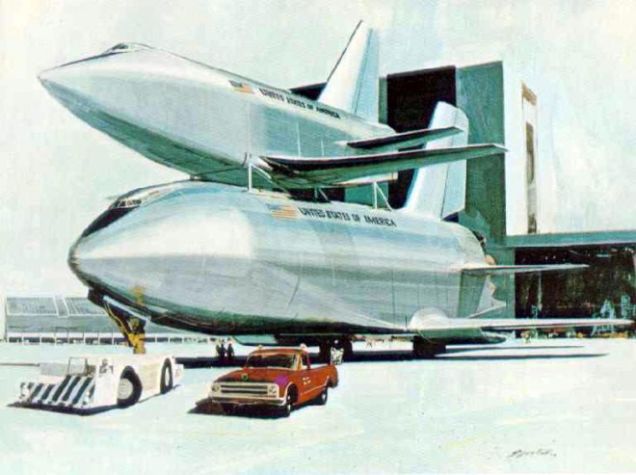
An early design concept for the Shuttle, with a piloted fuel tank below and the orbiter above. (NASA)
Not only did they have to redesign the Shuttle, they had to rethink the entire space station concept. NASA had originally planned for the station to be a large, single unit like Skylab. But changing the concept of the space station to one of modular construction, as we see today in the !!!error: Indecipherable SUB-paragraph formatting!!! (ISS), allowed NASA to reimagine the Shuttle as a vehicle that would carry those modules into orbit while also providing the payload space the Air Force required. Two basic design concepts then emerged. The first was called parallel burn, where the orbiter’s engine would be ignited at launch and burn in tandem with solid rocket boosters. The second was called series burn, where the orbiter’s engines would not fire until after the booster rockets were finished. Following a careful analysis of the cost of both systems, NASA opted for parallel burn, and announced on March 15, 1972 that the final design would be essentially what we see today: an orbiter attached to a !!!error: Indecipherable SUB-paragraph formatting!!! (EFT) and lifted by two !!!error: Indecipherable SUB-paragraph formatting!!! (SRBs). Of these three elements, the orbiter and the SRBs would be reusable. The SRBs would separate from the fuel tank after their solid fuel was expended and parachute back to Earth to be reused. The orbiter would re-enter Earth’s atmosphere after its mission and glide to a landing. The external fuel tank, which carried liquid hydrogen fuel and liquid oxygen oxidizer to power the orbiter’s main engines, would be expendable, breaking up in the atmosphere before impacting the Indian Ocean.
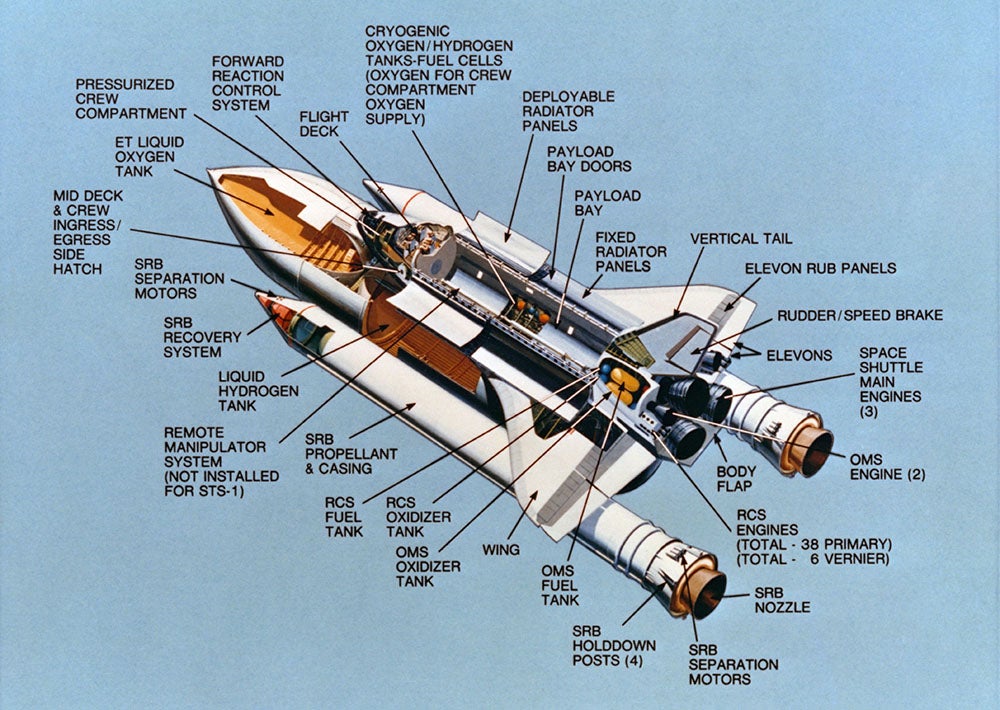
A cutaway view of the final Space Shuttle design, with reusable booster rockets, external fuel tank, and the orbiter (NASA)
On July 25, 1972, NASA awarded a contract for development and construction of the Space Shuttle to the International Space Division of Rockwell, as well as management of the overall integration of the vehicle and the launch system. With the general design finalized, the prototype orbiter !!!error: Indecipherable SUB-paragraph formatting!!! was the first to be built in 1976. Though it never went to space, it was used for critical free-flight testing. Four operational Shuttles, !!!error: Indecipherable SUB-paragraph formatting!!! , !!!error: Indecipherable SUB-paragraph formatting!!! , !!!error: Indecipherable SUB-paragraph formatting!!! , and !!!error: Indecipherable SUB-paragraph formatting!!! were built, and Columbia made the maiden flight of the Space Shuttle program on April 12, 1981. Two Shuttles, Challenger and Columbia , were lost to accidents, and a fifth operational Shuttle, !!!error: Indecipherable SUB-paragraph formatting!!! , was built in 1991 to replace Challenger . All told, the five Shuttles completed 133 missions during their 30 years of service, and the Space Shuttle program ended with the final flight of Atlantis on July 21, 2011.
!!! UNKNOWN CONTENT TYPE !!!
Short Takeoff
!!! UNKNOWN CONTENT TYPE !!!
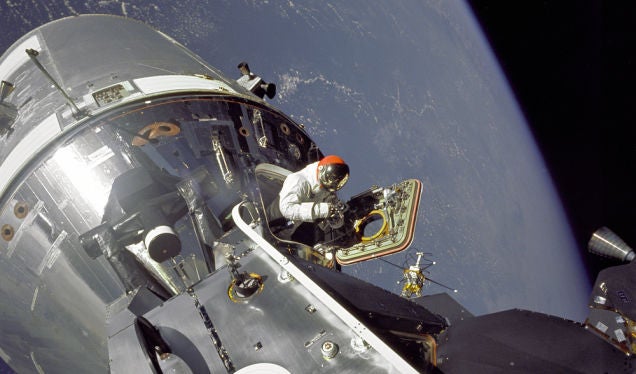
(NASA)
March 13, 1969 – Apollo 9 returns to Earth. A critical rehearsal for the !!!error: Indecipherable SUB-paragraph formatting!!! landing on the Moon, Apollo 9 was launched from Kennedy Space Center on March 3, 1969 as the third manned mission of the !!!error: Indecipherable SUB-paragraph formatting!!! and spent 10 days in Earth orbit. Apollo 9 marked the first flight of the complete Apollo spacecraft, with both the !!!error: Indecipherable SUB-paragraph formatting!!! (CSM) and !!!error: Indecipherable SUB-paragraph formatting!!! (LM) launched atop the !!!error: Indecipherable SUB-paragraph formatting!!! rocket. During three spacewalks, the crew tested new self-contained spacesuits that would be used on the Moon, and performed docking and flight tests of the LM. The flights of the LM, testing both descent and ascent engines, marked the first flight of a spacecraft that was not designed to return to Earth. Apollo 9 splashed down 160 miles east of the Bahamas, the last time a spacecraft splashed down in the Atlantic Ocean.
!!! UNKNOWN CONTENT TYPE !!!
 !!!CAPTION ERROR: MAY BE MULTI-LINE OR CONTAIN LINK!!!
!!!CAPTION ERROR: MAY BE MULTI-LINE OR CONTAIN LINK!!!
March 14, 1947 – The first flight of the Lockheed L-749 Constellation,
an improved version of the
!!!error: Indecipherable SUB-paragraph formatting!!!
and the first of the Constellation series to make regular crossings of the Atlantic Ocean. The “Connie” originally entered service with the US Army Air Forces in WWII, and it became one of the great intercontinental airliners when it entered commercial service after the war. The L-749 provided increased range, plus the addition of
!!!error: Indecipherable SUB-paragraph formatting!!!
exhaust manifolds that increased speed. Further development yielded the L-749A in 1949, which featured a strengthened fuselage and more robust landing gear. The first L-749 was delivered to
!!!error: Indecipherable SUB-paragraph formatting!!!
on April 18, 1947, and ultimately 119 L-749s were produced between 1947-1951 before the introduction of the
!!!error: Indecipherable SUB-paragraph formatting!!!
.
!!! UNKNOWN CONTENT TYPE !!!
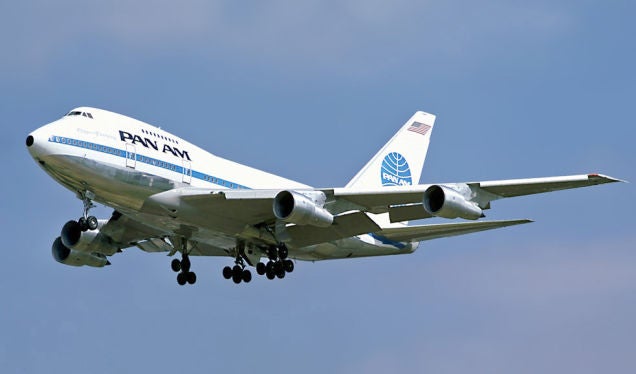 !!!CAPTION ERROR: MAY BE MULTI-LINE OR CONTAIN LINK!!!
!!!CAPTION ERROR: MAY BE MULTI-LINE OR CONTAIN LINK!!!
March 14, 1927 – Pan American World Airways is founded. Better known as Pan Am, the company was started by the United States government in 1927 as a shell company to counter the German-owned Colombian carrier !!!error: Indecipherable SUB-paragraph formatting!!! . Under the leadership of !!!error: Indecipherable SUB-paragraph formatting!!! , Pan Am grew rapidly by aggressively buying small airlines and expanding mail and passenger routes in South America. By 1937, Pan Am was providing !!!error: Indecipherable SUB-paragraph formatting!!! seaplane service to Europe, and had started pushing westward from the US to Hawaii and the Far East flying the !!!error: Indecipherable SUB-paragraph formatting!!! and the pressurized !!!error: Indecipherable SUB-paragraph formatting!!! . Following WWII, Pan Am continued to expand its routes as it entered the jet age, and was the launch customer for both the !!!error: Indecipherable SUB-paragraph formatting!!! and !!!error: Indecipherable SUB-paragraph formatting!!! . At its peak in the 1960s, Pan Am carried 6.7 million passengers and served 86 countries on every continent except Antarctica. By the 1970s, the !!!error: Indecipherable SUB-paragraph formatting!!! led to higher fuel prices and fewer travelers, and Pan Am found themselves in massive amounts of debt. After attempting to acquire domestic airlines and selling off major portions of its assets, the remainder of the company was !!!error: Indecipherable SUB-paragraph formatting!!! by Delta Air Lines in 1991 for $1.39 billion.
!!! UNKNOWN CONTENT TYPE !!!
Connecting Flights
!!! UNKNOWN CONTENT TYPE !!!
!!! UNKNOWN CONTENT TYPE !!!
!!! UNKNOWN CONTENT TYPE !!!
!!! UNKNOWN CONTENT TYPE !!!
!!! UNKNOWN CONTENT TYPE !!!
If you enjoy these Aviation History posts, please let me know in the comments. And if you missed any of the past articles, you can find them all at
!!!error: Indecipherable SUB-paragraph formatting!!!
. You can also find more stories about aviation, aviators and airplane oddities at
!!!error: Indecipherable SUB-paragraph formatting!!!
.
!!! UNKNOWN CONTENT TYPE !!!
 OPPOsaurus WRX
> ttyymmnn
OPPOsaurus WRX
> ttyymmnn
03/15/2019 at 12:38 |
|
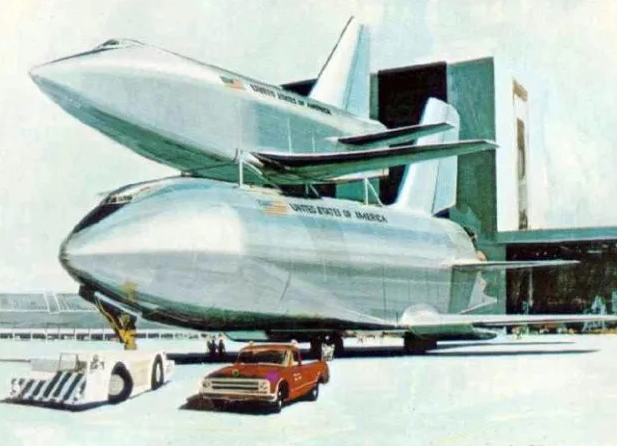
this looks like one of those photos that is supposed to prove time travel. its all futuristic and then three is this boxy truck that traveled to the future and brought the photo back to prove it.
 Chariotoflove
> ttyymmnn
Chariotoflove
> ttyymmnn
03/15/2019 at 13:15 |
|
I wondered why Enterprise was never refitted for spaceflight or used to replace Challenger . It turns out it was meant to, but building Endeavor from parts and frames they had was easier than fitting Enterprise with the proper systems and external materials. That seems a little counter-intuitive, but then I guess it’s the same with terrestrial construction. Remodeling a home, beyond a certain structural point, becomes less cost-effective than building new.
 You can tell a Finn but you can't tell him much
> ttyymmnn
You can tell a Finn but you can't tell him much
> ttyymmnn
03/15/2019 at 13:32 |
|
Here is some interesting stuff from the Space Shuttle program that you’ll like. I really want to see the model.
 ttyymmnn
> You can tell a Finn but you can't tell him much
ttyymmnn
> You can tell a Finn but you can't tell him much
03/15/2019 at 13:37 |
|
Thanks! I’ll have to watch this a little later.
 user314
> ttyymmnn
user314
> ttyymmnn
03/15/2019 at 13:43 |
|
And now, looking back on it with 40 years of hindsight, the Shuttle was a mistake , and we would have been better off with continuing with the Saturn V, a derivative thereof , or the proposed Nova-class .
 user314
> Chariotoflove
user314
> Chariotoflove
03/15/2019 at 15:02 |
|
Yeah, Rockwell may have claimed the Enterprise could be refitted for spaceflight, but the reality is that the design changed so much between the prototypes and production models, and so much was left off Enterprise that building Challenger out of a Structural Test Article was cheaper and easier. That they came to the same conclusion after the loss of Challenger isn’t really a surprise.
 BaconSandwich is tasty.
> ttyymmnn
BaconSandwich is tasty.
> ttyymmnn
03/16/2019 at 01:01 |
|
Not sure if you have seen this story about the clipper before: https://medium.com/s/story/the-long-way-round-the-plane-that-accidentally-circumnavigated-the-world-c04ca734c6bb?fbclid=IwAR23ZcivAuOQEPhwE-wUaoI5ECJkzowpV98Lh5Hd58t3XbYLNctdf9IrXHE
Well worth the read.
 ttyymmnn
> user314
ttyymmnn
> user314
03/19/2019 at 08:34 |
|
Some researchers have criticized a pervasive shift in NASA culture away from safety in order to ensure that launches took place in a timely fashion, sometimes called “ go fever ”. Allegedly, NASA upper-level management embraced this decreased safety focus in the 1980s while some engineers remained wary. According to sociologist Diane Vaughan , the aggressive launch schedules arose in the Reagan years as a way to rehabilitate America’s post- Vietnam prestige.
I find it ironic that one of the reasons for listing the Shuttle as a failure was that it didn’t reach the number of launches that designers had hoped for. But making something safe takes time, and NASA was in a damned if you do, damned if you don’t situation where they could take their time and do it right or rush to make launch targets and do it wrong. While I agree that the spacecraft didn’t reach the perhaps unattainable goals of its creators, I think it’s a little harsh to call it a failure.
And now, Trump wants us to go to the moon before the 2020 election.
 user314
> ttyymmnn
user314
> ttyymmnn
03/19/2019 at 09:56 |
|
Whatever else is going on, dumping Shelby’s Lunch System for SpaceX or Blue Origin is a good thing in my book.
 ttyymmnn
> user314
ttyymmnn
> user314
03/19/2019 at 10:12 |
|
I don’t follow the space program very much, but I do wonder if there are available launch systems in place now, why did NASA feel they needed to reinvent the wheel? Is that just the culture at NASA? Or is industry selling it to Congress?
 user314
> ttyymmnn
user314
> ttyymmnn
03/19/2019 at 10:40 |
|
Yes to both, but also timing.
NASA has been working on getting a compliment to/replacement for Shuttle since the middle Aughts. The first program was Constellation , which produced nothing. In 2010 they tried again; and Congress, with ULA’s lobbyists whispering in their collective ears, decided the new unit would be based on as much of the Shuttle’s hardware as was possible since it would be cheaper and more efficient keep pork going to the right districts. Enter the SLS . So far that’s accomplished little more than ripping the main engines out of the Shuttles, both to study so they can build more, and to throw away on future flights (if they actually happen). The first launch, which would put an unmanned capsule into orbit around the moon, has been slipping further and further behind schedule, and is now tentatively targeted for some time in 2020, though with the shift away from SLS to Falcon Heavy or Delta IV Heavy would accelerate that a bit.
 ttyymmnn
> user314
ttyymmnn
> user314
03/19/2019 at 10:49 |
|
ULA?
 user314
> ttyymmnn
user314
> ttyymmnn
03/19/2019 at 10:56 |
|
United Launch Alliance , the space launch joint venture formed between LockMart and Boeing. If you ever come across the phrase “Old Space”, that’s who they’re talking about.